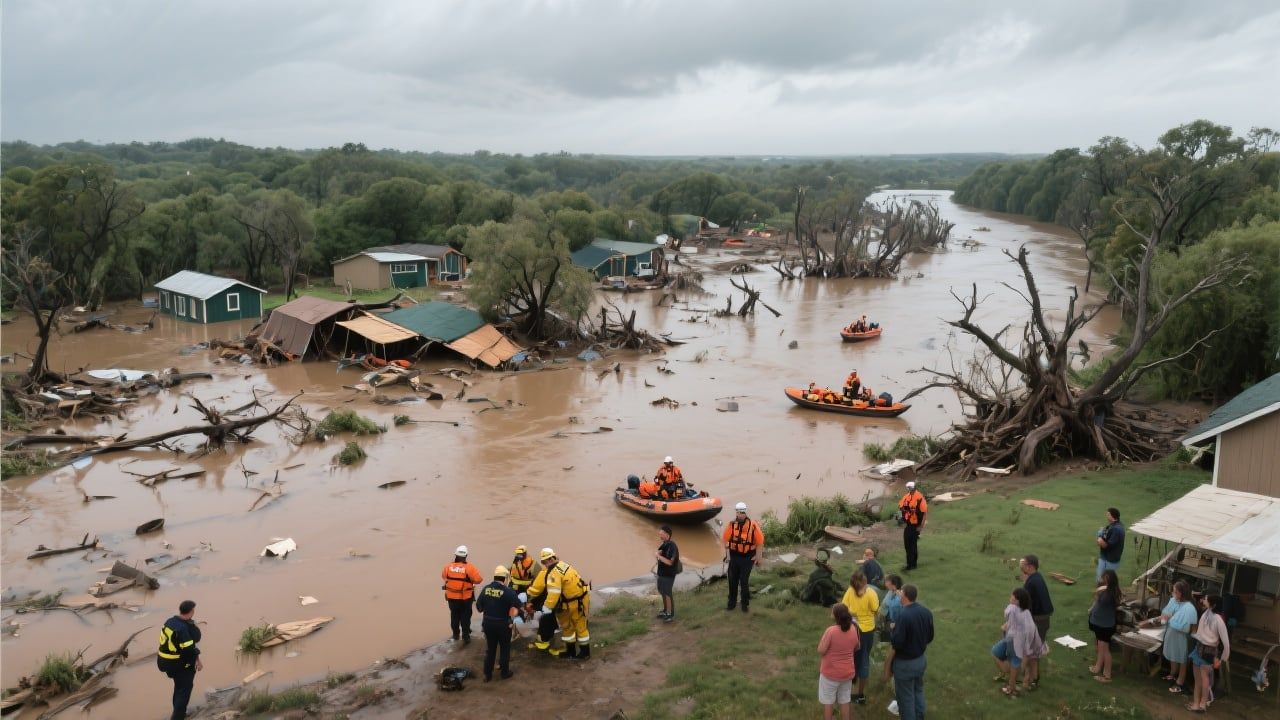
For generations, the Guadalupe River has been a living postcard of Texas Hill Country its cool, winding waters a magnet for summer camps, family reunions, and the kind of lazy afternoons that etch themselves into memory.
But in the early hours of July 4, 2025, that familiar river became unrecognizable. A wall of water, fueled by record-breaking rainfall, swept through Kerr County and beyond, leaving behind a landscape of devastation, heartbreak, and questions that refuse to recede.
The death toll has climbed past 110, with dozens of children among the victims and more than 170 people still missing. The river that once promised adventure now stands as a symbol of collective grief and uncertainty, its future and the future of those who live along its banks hanging in the balance.
The Anatomy of a Catastrophe
A Perfect Storm, a Vulnerable Landscape
The disaster was set in motion by a slow-moving, supercharged thunderstorm system, drawing moisture from the remnants of Tropical Storm Barry. The Hill Country’s unique geography rugged hills, narrow river basins, and drought-hardened soil meant the deluge had nowhere to go but straight into the Guadalupe and its tributaries. In some places, more than 20 inches of rain fell in a matter of hours, a meteorological event so rare that even seasoned forecasters struggled to find precedent.
The river’s rise was both historic and horrifying. In Hunt, the water surged 22 feet in just two hours. Downstream in Kerrville, the river leapt from less than two feet to over 34 feet in barely an hour. The timing could not have been worse: the banks were crowded with vacationers and children at summer camps, many of them asleep and unaware of the looming danger.
Human Toll: Stories of Loss and Survival
The numbers are staggering at least 87 dead in Kerr County alone, including 30 children. Camp Mystic, a nearly century-old summer camp, lost 27 campers and counselors in a single night. Survivors describe scenes that defy belief: families clinging to trees, cabins swept away in darkness, and the haunting sound of water where laughter had echoed just hours before.
One mother, Erin Burgess, recounted how she and her son survived by holding onto each other as the current tore their home apart. “That’s the only thing that saved me,” she said, her voice still raw with disbelief.
The Blame Game: Warnings, Cuts, and Communication Breakdowns
Did the Weather Service Fail, or Was It Ignored?
In the aftermath, a bitter debate has erupted over who, or what, is to blame. Local officials insist the National Weather Service (NWS) failed to predict the true scale of the disaster. “No one knew there would be a 30-foot high tsunami of water,” said Governor Greg Abbott, echoing the frustration of many on the ground (NBC News).
But the NWS and independent meteorologists push back, pointing to a clear timeline of escalating warnings. Flash Flood Watches and Warnings were issued more than 12 hours before the river crested, with urgent alerts sent to cell phones and posted on social media. The most dire warning a Flash Flood Emergency was issued at 4:03 a.m., urging residents to “SEEK HIGHER GROUND NOW!”
The disconnect, it seems, was not in the data but in how it was received and acted upon. Some residents reported never getting alerts. Others, like Matthew Stone, said police knocked on their doors only minutes before the flood hit. The local emergency notification system, CodeRED, was delayed by bureaucratic hurdles at a critical moment.
The Shadow of Federal Cuts
Overlaying this tragedy is a political storm of its own. In the months leading up to the flood, the NWS lost nearly 600 employees nationwide due to federal budget cuts and buyouts, with the Austin/San Antonio office responsible for Kerr County operating with a 23% vacancy rate. The position of Warning Coordination Meteorologist, a key role for local communication, was unfilled at the time of the disaster.
FEMA, too, was reeling from budget reductions, hampering its ability to respond quickly and effectively. Critics argue that these cuts left the nation’s disaster response system dangerously hollowed out, with the Guadalupe tragedy as a grim case study.
The Uncertain Future: Can the River and Its People Recover?
Picking Up the Pieces
As search-and-rescue teams continue their grim work, the communities along the Guadalupe face a future clouded by loss and anxiety. The river’s role as a source of joy and economic lifeblood is now in question. Summer camps, once the heart of the region’s identity, are shuttered indefinitely. Families debate whether to rebuild or move on.
There is also a reckoning underway about how warnings are communicated and acted upon. State legislators have promised investigations, but the deeper challenge may be cultural: how to foster a sense of urgency and trust in a world where extreme weather is becoming the new normal.
A River’s Legacy, Rewritten
The Guadalupe will flow again, but it will never be the same. Its banks are now marked by memorials and the memory of a night when everything changed. For those who loved the river, the task ahead is not just rebuilding homes, but restoring faith in each other, in the systems meant to protect them, and in the possibility of joy returning to the water’s edge.
